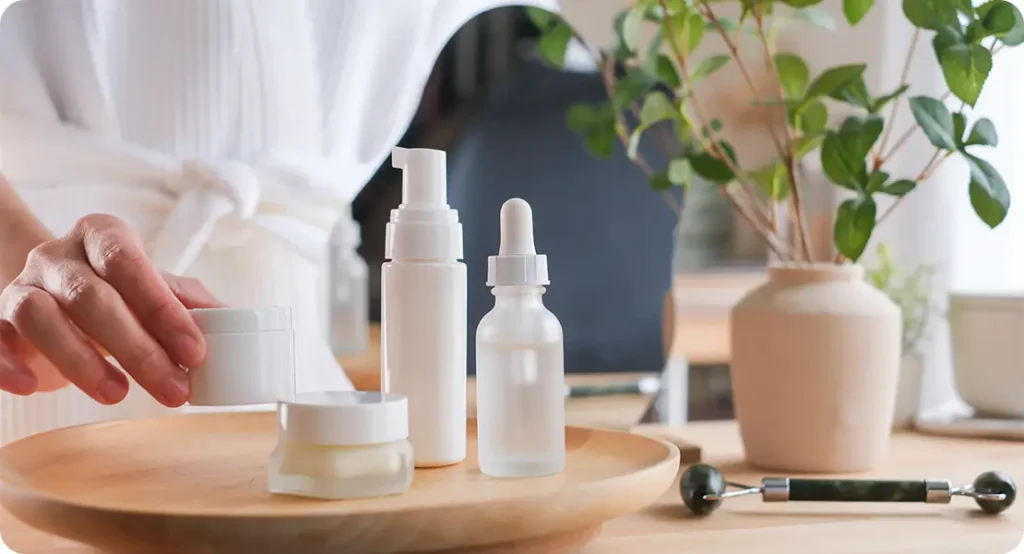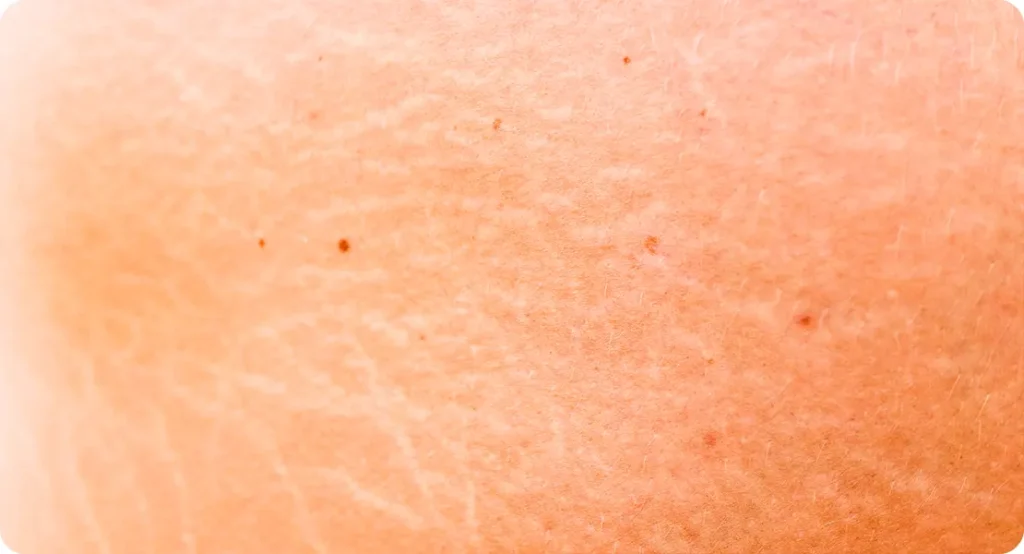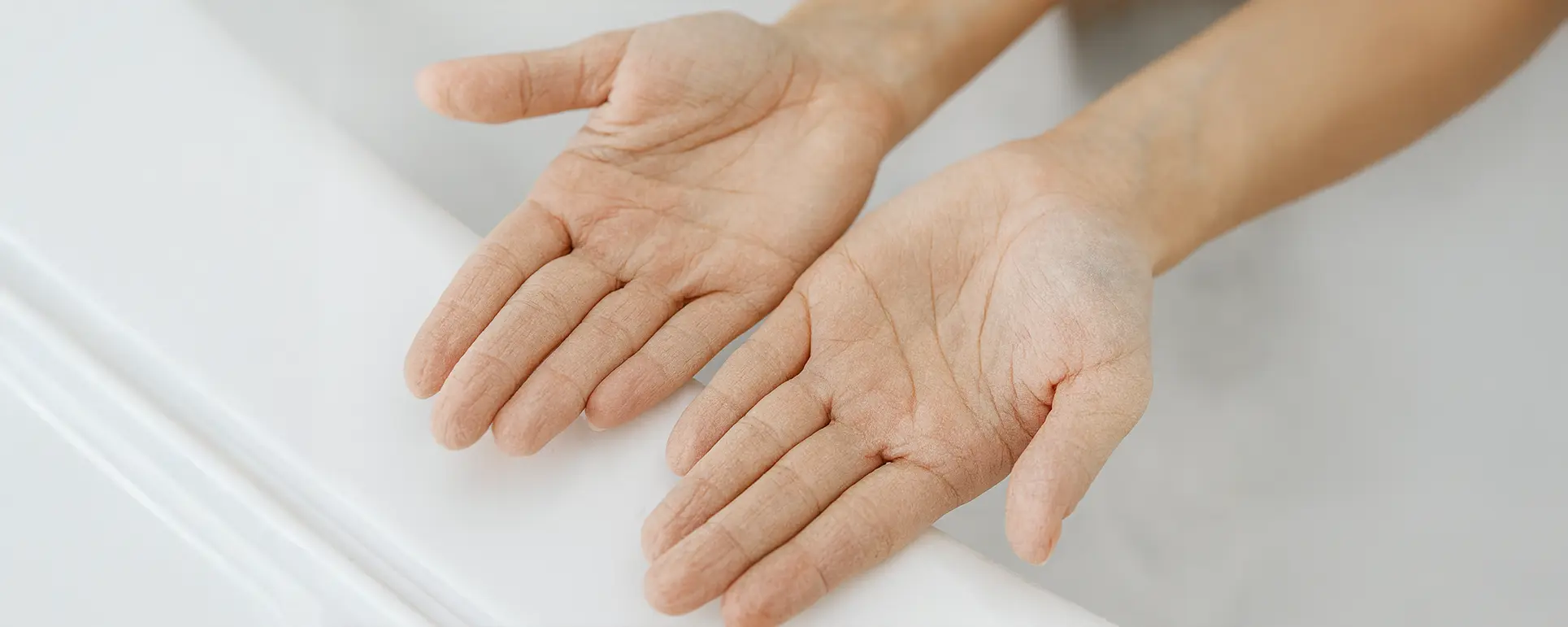Everyone experiences dry skin from time to time especially during the colder months or after using harsh soaps. But what if your dry, flaky skin just won’t go away, no matter what you do? If you’re constantly battling rough patches, redness, irritation, or that uncomfortable tight feeling even after trying every moisturiser, serum, or skin remedy you can get your hands on then something deeper could be going on beneath the surface.
Persistent dryness isn’t always just a cosmetic issue. It can be a sign that your skin barrier is compromised, or that you may be dealing with an underlying condition like eczema, psoriasis, or even a misdiagnosed allergy. It’s easy to overlook chronic dryness as just “sensitive skin,” but if your usual products and routines aren’t working, it’s worth digging a little deeper.
And here’s another layer many people miss sometimes it’s not your skincare that’s the problem, but your overall environment or lifestyle. Things like indoor heating, air conditioning, hot showers, poor diet, or even stress can all play a role in drying out your skin. Even the way you cleanse or towel-dry your face can make a difference. The skin is your body’s largest organ, and it reflects what’s going on both inside and out.
In this article, we’ll explore some of the most common and commonly misunderstood causes of stubborn dry and peeling skin. From environmental triggers to overlooked medical conditions, we’ll guide you through what to watch for and, most importantly, when to seek expert advice. Because sometimes, the best thing you can do for your skin is to stop guessing and talk to a professional.
1. You Might Be Misdiagnosing It as “Just Dry Skin”
When your skin starts flaking, it’s easy to assume it’s just dryness. Most of us instinctively reach for a heavier moisturiser, a soothing balm, or perhaps a hydrating serum in hopes of calming things down. But what if the real issue isn’t dry skin at all?
Several skin conditions can mimic the appearance of dryness and flaking but require entirely different approaches to treatment. Two of the most common culprits are seborrhoeic dermatitis and psoriasis. While they may look similar at a glance both can cause scaling, redness, and irritation they’re rooted in completely different underlying causes.
Seborrhoeic dermatitis typically shows up in areas rich in oil glands, such as the scalp, eyebrows, sides of the nose, behind the ears, and even on the chest. It often appears as greasy-looking flakes or yellowish scales on a red base, and may be mistaken for dandruff when on the scalp. Applying regular moisturiser might temporarily soothe the skin, but it won’t address the inflammation or fungal imbalance that usually drives this condition.
Psoriasis, by contrast, is an autoimmune condition that speeds up skin cell turnover, leading to thick, silvery plaques that can be itchy, painful, or even crack and bleed. It can occur on the elbows, knees, scalp, or even nails, and tends to be chronic. Slathering on creams may soften the skin temporarily, but without targeted treatment like medicated creams or systemic therapy the plaques often persist or worsen.
This is why a proper diagnosis is so important. Treating the wrong condition can lead to more irritation, wasted money on ineffective products, and prolonged discomfort. If your “dry skin” isn’t responding to over-the-counter remedies, it’s worth consulting a dermatologist to rule out other possibilities and get a treatment plan tailored to your specific skin needs.
Key signs it might not be “just dry skin”:
- Moisturiser brings little or no relief
- Flaking occurs in oily areas like the scalp or sides of the nose
- Patches are red, inflamed, or have silvery scales
- Itching, burning, or soreness accompanies the dryness
- The condition keeps recurring or getting worse
2. Your Products Could Be Making It Worse

It might sound surprising, but sometimes the very products you’re using to treat dry skin could actually be making the problem worse. Many moisturisers, cleansers, and serums especially those marketed as “hydrating” or “anti-ageing” contain ingredients that can irritate sensitive or already compromised skin.
Common offenders include fragrances, alcohols, and harsh exfoliating agents like alpha hydroxy acids (AHAs), salicylic acid, or scrubs with gritty textures. These ingredients can strip the skin’s natural oils and damage the protective moisture barrier, which is crucial for keeping hydration locked in. Once that barrier is weakened, your skin loses moisture more quickly and becomes more prone to irritation, flaking, and redness.
Even popular skincare steps like double cleansing or frequent exfoliation though well-intentioned can be too aggressive if your skin is already dry and reactive. And while active ingredients like retinoids, vitamin C, and glycolic acid have their place in skincare, overuse or improper layering can backfire on delicate skin.
To support your skin’s recovery, look for gentle, non-comedogenic, and fragrance-free products specifically formulated for sensitive or dry skin. Ingredients like ceramides, glycerin, niacinamide, and hyaluronic acid can help rebuild the skin’s barrier and improve moisture retention over time without causing further irritation.
Still feeling confused by labels or unsure whether your routine is helping or hurting? That’s where professional guidance can make all the difference. A dermatologist can assess your skin type, identify potential irritants in your current products, and recommend a skincare routine tailored to your unique needs so you’re not stuck in a frustrating cycle of trial and error.
Signs your skincare products may be doing more harm than good:
- Stinging, burning, or itching after application
- Increased redness, flakiness, or tightness despite moisturising
- Using too many actives or exfoliants at once
- Relying on strongly fragranced or alcohol-based products
- No visible improvement after several weeks of consistent use
3. Environmental Triggers May Be to Blame
Sometimes, it’s not what you’re putting on your skin that’s the problem it’s what your skin is exposed to every single day. Environmental factors are one of the most common and often overlooked causes of persistent dryness and flaking. Even if you’re using high-quality skincare, these external triggers can undo your efforts and keep your skin in a constant state of irritation.
Cold weather, for instance, is a major culprit. When temperatures drop, so does humidity both indoors and out. The dry, chilly air draws moisture from your skin, leaving it tight, rough, and vulnerable. Combine that with central heating systems blasting warm, dry air indoors, and your skin’s natural moisture barrier is under attack from all sides.
And it doesn’t stop in the winter. Air conditioning during the summer months can have a similar dehydrating effect on the skin, constantly circulating dry air that strips away essential oils. Even something as routine as your daily shower can be an issue long, hot showers may feel relaxing, but they can actually damage the outermost layer of your skin, removing the lipids that help retain moisture.
So what can you do? Start by making small, skin-friendly lifestyle tweaks:
- Use a humidifier in your bedroom or living space, especially in winter, to add moisture back into the air and keep your skin from drying out overnight.
- Limit your shower time to under 10 minutes, and opt for lukewarm water instead of hot.
- Swap out drying soaps for mild, fragrance-free cleansers that won’t strip your skin.
- After bathing, always pat not rub your skin dry with a soft towel, and immediately apply a rich emollient or body cream while your skin is still damp. This helps seal in hydration and prevent transepidermal water loss.
By identifying and managing these environmental stressors, you can give your skin a much-needed break and create the right conditions for it to heal and stay moisturised.
Signs your environment might be drying out your skin:
- Skin feels tighter or itchier in colder seasons
- Central heating or air conditioning is used frequently indoors
- You enjoy long, hot showers daily
- Skin often feels dry even with regular moisturising
- Indoor air feels dry, especially at night
4. It Could Be a Sign of an Underlying Condition

If your dry, flaky skin refuses to improve no matter how careful you are with your routine or environment, it might be time to look deeper. Chronic skin dryness isn’t always a stand-alone issue it can often be a symptom of an underlying medical condition that requires targeted treatment. In fact, several health-related issues can manifest through persistent skin symptoms, and recognising them early can make a big difference.
Some of the most common underlying causes include:
- Eczema (atopic dermatitis) – This is a chronic inflammatory skin condition that leads to dry, itchy, and inflamed skin. It can flare up in response to allergens, irritants, stress, or even weather changes. Eczema is more than just dry skin it can disrupt sleep, impact quality of life, and often needs prescription-strength treatments to manage effectively.
- Psoriasis – An autoimmune condition that speeds up the life cycle of skin cells, causing them to build up rapidly on the surface. This results in thick, scaly plaques that are often itchy, red, and painful. Unlike dry skin, psoriasis typically requires specialised treatments like topical steroids, phototherapy, or immune-modulating medications.
- Seborrhoeic dermatitis – A common condition that causes greasy, flaky skin in areas rich in oil glands, such as the scalp, eyebrows, nose, and chest. It’s often mistaken for simple dryness or dandruff but is believed to be related to an overgrowth of yeast on the skin. Antifungal treatments or medicated shampoos are often needed to control it.
- Fungal infections – Conditions like tinea (ringworm) can sometimes appear as dry, flaky patches, especially on the body or feet. These infections won’t respond to moisturisers and can worsen if left untreated. An antifungal cream is typically needed to clear them up.
- Thyroid dysfunction – An underactive thyroid (hypothyroidism) can slow down your body’s metabolism, which may affect skin regeneration and oil production. This often leads to coarse, dry, and rough skin especially on the elbows, knees, and lower legs. If you notice other symptoms like fatigue, weight gain, or hair thinning, a thyroid test might be in order.
- Nutritional deficiencies – Low levels of certain nutrients, particularly essential fatty acids, vitamin A, vitamin D, or zinc, can lead to rough, dry skin. These deficiencies are often linked to restrictive diets, digestive disorders, or poor absorption.
If you suspect your skin symptoms may be tied to a deeper health issue, it’s best not to self-diagnose. A qualified dermatologist can conduct a thorough skin examination, run specific tests, and collaborate with other healthcare providers if needed. Getting the right diagnosis means you can move beyond temporary fixes and start addressing the true root of the problem.
Signs your dry skin could be linked to a medical issue:
- Persistent flaking or scaling that resists moisturisers
- Itchy, red, or inflamed patches that worsen over time
- Rough skin combined with other symptoms like fatigue or weight changes
- Flaky patches in oily areas (scalp, nose, eyebrows)
- Dry skin accompanied by frequent infections or delayed healing
- No improvement despite avoiding environmental and product triggers
5. Chronic Skin Conditions Need More Than Moisturiser
If you’ve been dealing with dry, flaky skin for weeks or even months with little to no improvement, it’s a clear sign that moisturiser alone isn’t going to cut it. While hydrating lotions and creams can help soothe the skin’s surface temporarily, they don’t address the underlying cause when it comes to chronic skin conditions. In fact, continuing to rely on moisturisers without a proper diagnosis can delay effective treatment and prolong discomfort.
Long-term skin concerns such as seborrhoeic dermatitis, psoriasis, eczema, or fungal infections typically require medical-grade treatments that go beyond over-the-counter products. These treatments are designed to reduce inflammation, combat infections, restore skin balance, and promote healing from within.
Depending on your diagnosis, your dermatologist might recommend:
- Topical steroid creams or ointments – To reduce inflammation and itchiness in conditions like eczema or psoriasis.
- Antifungal creams or shampoos – Especially for seborrhoeic dermatitis or fungal infections like tinea, which won’t respond to moisturisers.
- Calcineurin inhibitors – non-steroidal options used to calm flare-ups in sensitive areas like the face or eyelids.
- Coal tar preparations or salicylic acid – Often used for psoriasis to help shed dead skin and reduce scaling.
- Phototherapy (light therapy) – A dermatologist-administered treatment that uses controlled UV light to slow abnormal skin cell growth and reduce inflammation.
- Oral medications or biologics – In more severe or widespread cases of chronic skin disease, systemic treatments may be needed to manage the condition from within.
While it may feel frustrating to go beyond simple solutions, the benefit of seeking medical care is that you’re getting treatment tailored to your condition, not just masking symptoms. Chronic skin issues can be stubborn, and guessing your way through random products is not only disheartening it’s often expensive.
The truth is, your skin deserves more than a one-size-fits-all approach. By taking the time to consult a specialist, you’re investing in real, long-term results. You’re not just treating dry skin you’re addressing the reason behind it and giving your skin the targeted care it actually needs.
Signs your dry skin may require expert treatment:
- No improvement after weeks of using moisturisers
- Patches are inflamed, painful, or spreading
- Over-the-counter remedies provide only short-term relief
- Symptoms return as soon as treatment stops
- The condition affects your quality of life or confidence
- You’ve tried multiple products with no success
Final Thought: When It’s Time to Dig Deeper Than Dry Skin
If you’ve been dealing with stubborn dry, flaky skin that refuses to improve despite your best efforts it may be time to stop treating the symptoms and start investigating the root cause. While moisturisers and over-the-counter products can offer short-term relief, they’re often not enough when the issue runs deeper, such as an undiagnosed skin condition, environmental stressors, or internal health concerns.
You don’t have to keep guessing or wasting money on products that don’t work. Getting professional guidance is one of the most effective steps you can take toward lasting relief and healthier, more resilient skin. Get in touch with us to schedule a consultation with one of our expert dermatologists and discover long-term solutions personalised to your skin’s needs.
References:
- Egawa, M., Iwagaki, H., Honda, T., Kaku, Y., Takahashi, M. & Miyachi, Y. (2002) Effect of Exposure of Human Skin to a Dry Environment, Journal of Investigative Dermatology, 118(6), pp. 1168–1173. doi:10.1038/sj.jid.5700527. Available at: https://www.researchgate.net/publication/11042235_Effect_of_Exposure_of_Human_Skin_to_a_Dry_Environment
- Tenorio, M.L. et al. (2016) The effect of environmental humidity and temperature on skin barrier function and dermatitis, Journal of the European Academy of Dermatology and Venereology, 30(2), pp. 203–210. Available at: https://www.ncbi.nlm.nih.gov/books/nbk551707/
- Pierard-Franchimont, C., De Doncker, P., Degreef, H. & Pierard, G.E. (2013) Seborrheic dermatitis: etiology, risk factors, and treatments, Clinics in Dermatology, 31(4), pp. 380–389. Available at: https://pubmed.ncbi.nlm.nih.gov/27306376/
- Menter, A., et al. (2008) Guidelines of care for the management of psoriasis and psoriatic arthritis, Journal of the American Academy of Dermatology, 58(5), pp. 826–850. Wikipedia summary available at: https://en.wikipedia.org/wiki/Psoriasis
- Draelos, Z.D. (2018) Dry Skin: A to Z, Harvard Health Publishing. Available at: https://www.health.harvard.edu/a_to_z/dry-skin-a-to-z
